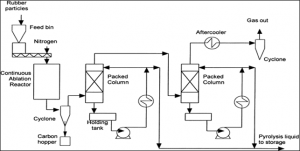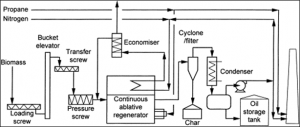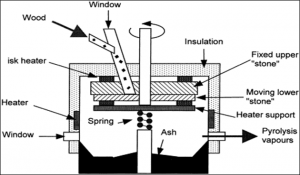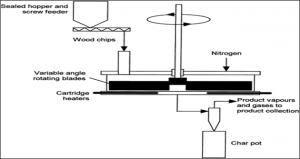Ablative Pyrolysis
Fast pyrolysis can be broken down into other types of pyrolysis; ablative pyrolysis, although similar to fast pyrolysis, is fundamentally different in how the heat transfer is received by the particles reacting. The heat transfer in this type of process is actually radiated from the reactor wall vs. particulate matter that converts particles in the reactor. Thusly, this pyrolysis process effectively “melts” the fuel for the reactor and everything will try to move along the same gradient within the reactor. High pressures are needed for this type of process, and temperatures are usually under 600 °C; the reaction rate for this process increases with the pressure, while in other types of pyrolysis the rate of reaction is limited by the heat transfer through the reacting particle. Theoretically, there is no ceiling to the particle size parameter for this type of reaction, but this type of pyrolysis reaction requires very high heat at the reactor wall. This type of pyrolysis does not require inert gas throughput for collection of the product gases, however the reactor should be mechanically effective/efficient such that the reacting material can be driven in the same direction. Scale up is not normally taken past the laboratory phase, although this process can be made commercial.
Flow Diagrams

(Source: http://www.sciencedirect.com/science/article/pii/S1364032199000076)

(Source: http://www.sciencedirect.com/science/article/pii/S1364032199000076)

(Source: http://www.sciencedirect.com/science/article/pii/S1364032199000076)

(Source: http://www.sciencedirect.com/science/article/pii/S1364032199000076)
Equipment
Sealed Hopper/Screw Feeder
Cartridge Heater
Disk Heater
Condenser
Cyclone Separator
Packed Column
Videos
Energolesprom_video
Ablative Pyrolyser
References
- http://www.youtube.com/watch?v=mKTOdv0Yk4s
- http://www.youtube.com/watch?v=oNHX08jI45k
- http://www.ars.usda.gov/Main/docs.htm?docid=19898
- http://biocharfarms.org/biochar_production_energy/
- http://www.sciencedirect.com/science/article/pii/S1364032199000076
- http://www.ikft.kit.edu/english/181.php
- http://www.pyne.co.uk/?_id=69
- http://www.sciencedirect.com/science/article/pii/S1364032199000076
- http://www.freepatentsonline.com/7202389.html
- http://alternativefuels2.tpub.com/3054/30540007.htm